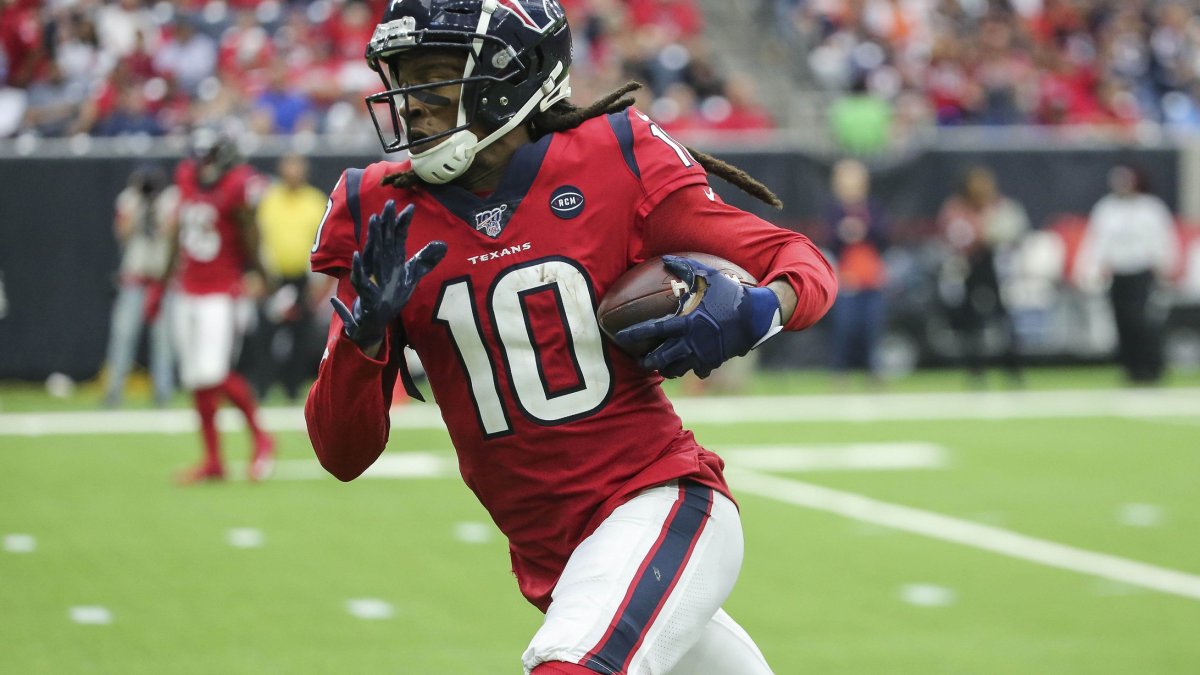We have our first blockbuster trade of 2020, as the Arizona Cardinals are sending David Johnson and a second-round pick to the Houston Texans in exchange for DeAndre Hopkins and a fourth-round pick. This is a shocking move that has massive ripple effects across the fantasy football landscape.
Hopkins has been one of fantasy’s elite options over the last half-decade. During that span, he has four top-five fantasy finishes and pulled off the rare back-to-back first-place finish in 2017 and 2018. While some view Hopkins’ 2019 campaign as a disappointment, this take seems a bit off. Hopkins posted his third 100-catch season and finished fifth among wideouts in fantasy scoring. The only real drop off was in his touchdown production, which is the most fickle fantasy stat from year to year.
In Arizona, Hopkins steps into an ideal situation. He’ll be paired with Kyler Murray, who flashed at times in his rookie season and is poised to take a big leap forward in Year 2. He will certainly benefit from Kliff Kingsbury’s up-tempo offense. Better yet, the incumbent depth chart isn’t exactly chock full of target monsters. Larry Fitzgerald is sticking around for another season, but his workload has dropped off pretty dramatically over the last two years. Christian Kirk is also in house. While the young receiver has flashed upside, he’s also shown a propensity for injury with seven missed games over the last two seasons.
Put that all together, and Hopkins figures to see massive volume for the Cards. He remains one of the top fantasy options at the position. Likewise, his presence will have a positive effect on Murray’s outlook. Unfortunately, that means you won’t be getting Murray at a discount in any of your fantasy drafts this year. We currently have Murray ranked as our No. 5 fantasy quarterback.
On the other side of this deal, Deshaun Watson is no doubt going to take a bit of a hit for fantasy purposes. It’s not that Hopkins was the only reason why Watson has been able to produce elite fantasy numbers, but he’s certainly a big part of the equation. The Texans do still have Will Fuller, and he figures to tentatively slot in as the de facto No. 1 receiver. While Fuller has flashed moments of fantasy brilliance, he has also been extremely injury prone. For now, Watson remains a top-six fantasy quarterback, and Fuller moves up into WR2 territory.
The good news for Watson is that he will have a reliable pass catcher out of the backfield in Johnson. The veteran back is coming off one of the most disappointing fantasy seasons in recent memory, but it didn’t start that way. He ranked ninth among running backs in fantasy scoring over the first six weeks of the season. But a midseason injury put Johnson on the sideline, and the Cardinals then traded for Kenyan Drake in Week 9. The rest is history.
Believe it or not, it wasn’t just the injury that paved the way for Drake’s emergence. Though Johnson was producing fantasy points over the first month and a half of the season, he actually wasn’t playing that well. His 1.99 yards after contact ranked 43rd out of 47 qualifying backs over that span. The inability to generate yards independent of his blockers is far from optimal and doesn’t bode particularly well for his fantasy prospects going forward.
With that being said, we did just see an older back with declining metrics post a career year with the Texans in Carlos Hyde. So, all things considered, this is one of the better landing spots for Johnson in the immediate future. He figures to slide in as the lead early-down back, but will unfortunately have Duke Johnson to content with in the passing game. Hyde finished as fantasy’s No. 28 running back last season, and David Johnson should be able to outperform that ranking. While we aren’t overly bullish on him, David Johnson projects to see enough volume to crack the top 20 fantasy running backs and could threaten for top-15 numbers.
This move solidifies Kenyan Drake as the Cardinals’ feature back, with Chase Edmonds slotting in as the No. 2. Drake ranked fourth among running backs in fantasy scoring over the final nine weeks of 2019. While it’s tough to envision him replicating that success, his favorable role and proven high ceiling position him ahead of Johnson as a front-end RB2 with very real RB1 potential in 2020.



 © 2024 PFF - all rights reserved.
© 2024 PFF - all rights reserved.